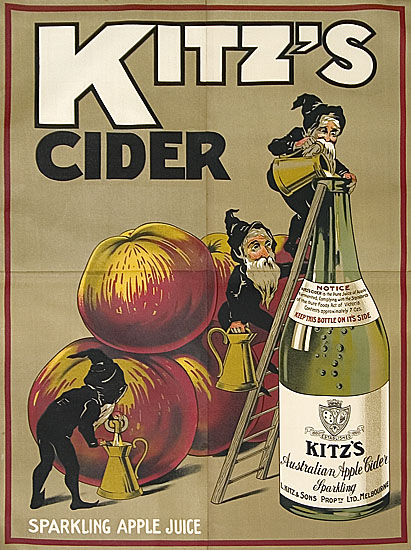Our Melbourne correspondent, Andrew Jenkins, investigates the bourgeoning Cider and Perry consumption in Australia, moreover is making some of his own with favourable results, least the local possums think so.
The Cider Report – Part One
I rather like Cider and Perry, but until relatively recently there has been a paucity of choice in the Australian market. The choice has been limited to the volume producers (too sweet and broad in flavour for my taste), with very honourable exceptions in the form of Kellybrook (a pioneer in the “artisan” mould) www.kellybrookwinery.com.au, Henry of Harcourt www.henrycider.com and a few others among the small specialty producers.
And of course there were always the wonderful Cidres and Poires from Normandy imported by Gabriel Chaise of Cerbaco. www.cerbaco.com.au
In 2008 I decided to make my own Cider, and I drove to Harcourt just north of Melbourne to seek out a quantity of apple juice. Long story short, one of the producers there persuaded me to take a large quantity of pear juice that was close to use by date, and make a Perry.
I started the process at home, in the kitchen, after cleaning out a beer fermenter, rehydrated and fed some champagne yeast and away we went. Within two days, the ferment had produced a pretty foul hydrogen sulphide smell and I was banished to the shed at the bottom of the garden with the fermenter, protesting that it wasn’t me. A dose of diamonium phosphate, or DAP, fixed the H2S, and after quite a short but vigorous and complete fermentation, I settled the fermented pear juice for a couple of weeks before bottling it in heavy champagne bottles with some carbonation drops.
The result was well received, and we had the last bottle just a few weeks ago with the Cider maker from local (Geelong area) Cider and Perry producer Flying Brick. It was still in good form, but probably should not have been. www.flyingbrickciderco.com.au

Kitz's Apple Cider original poster Circa 1920
In the interim, the Cider thing has taken off in Australia. According to the 2011 Cider Report issued by Nielson, Cider category sales in Australia over the twelve month period covered by the Report increased nearly 35% in value and a little over 23% in volume, with the category now representing 1.8% of total liquor purchases in Australia.
Another astonishing statistic is that over the 24 month period to the publishing of the Report, the number of active cider brands in the Australian liquor market has doubled, with 45 new brands introduced in that time.
Could there be any more growth in the Australian Cider category? The most relevant comparable market, the UK, has experienced terrific growth in the Cider category, and this now accounts for over 12% of liquor sales by value there. Mintel reports that in 2011, cider sales in the UK accounted for around 2.4 Billion Pounds (my computer doesn’t have a “pounds sterling” sign), up from 1.7 Billion in 2006, compared with 11.4 Billion Pounds in 2011 for Lager, losing 2.2 Billion Pounds in sales since 2006.
Mintel forecasts further growth in the Cider category in the UK (volume sales to increase 12% over the period to 2016).
The evidence in Australia suggests growth in Cider sales is coming and will continue to come at the expense of the RTD (ready to drink) and volume beer segments. No tears over that I would imagine.
In Australia, according to the Australia & New Zealand Food Standards, Cider must be made from apple juice with not more than 25% pear juice, and Perry must be made from pear juice with not more than 25% apple juice. A close look at the ingredient labelling of some products discloses the use of water and concentrate, which is more convenient than grinding and pressing fruit – a slow process indeed.
It’s funny what you learn when you start looking into these things, but pears are rich in an unfermentable sugar called sorbitol. Too much of this and there is a dangerously quick laxative effect. Perhaps this is why the allowance of 25% apple juice under the Food Standards for Perry. One of the newer producers, Napoleone & Co (Yarra Valley) has a product labelled “Apple with Pear Cider”, and perhaps it’s a product designed to provide pear flavour without the side effect. www.napoleonecider.com.au
I have started another Perry, which has now been bottled and I hope it turns out well. This time, having been advised that I used ten times the necessary quantity of yeast on my first effort, the ferment was less tumultuous and I managed to avoid the production of H2S.
But it’s always the little things that let you down. For example, a piece of rubber, slightly perished or perforated, can have unwanted side effects. The rubber ring on the tap in one of my fermenters failed, and I lost a large quantity of fermenting juice. The local possum population found this irresistible as it seeped out of my shed; I hope they paid the price.
All of this has given me the excuse to get around the market to taste what’s out there, and produce
Part Two of this Report coming
|
|
Tweet |



No comments to The Cider Report – Part One | Comments Feed
No comments yet
The comments are closed.